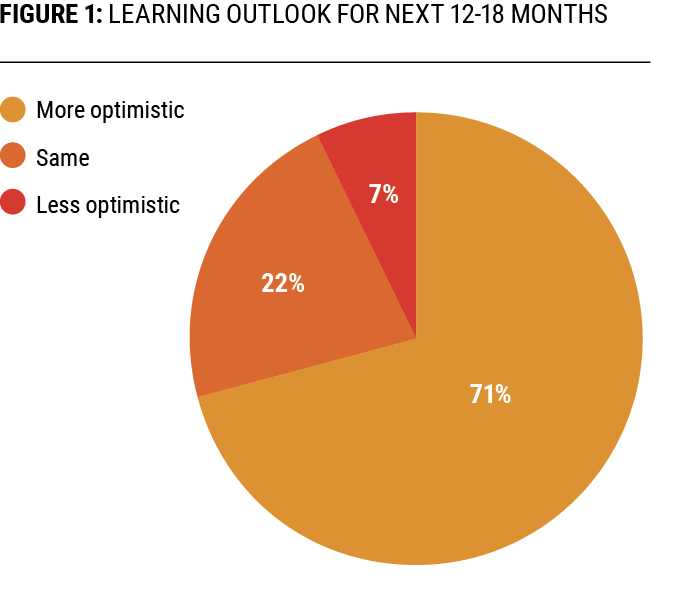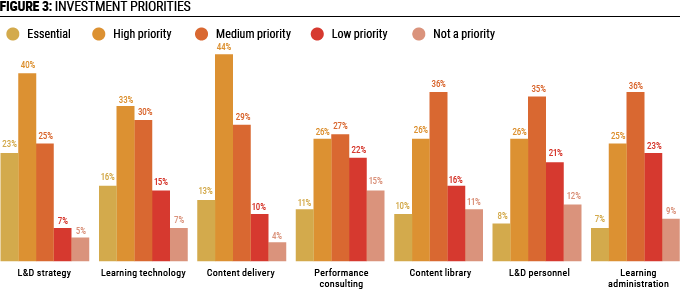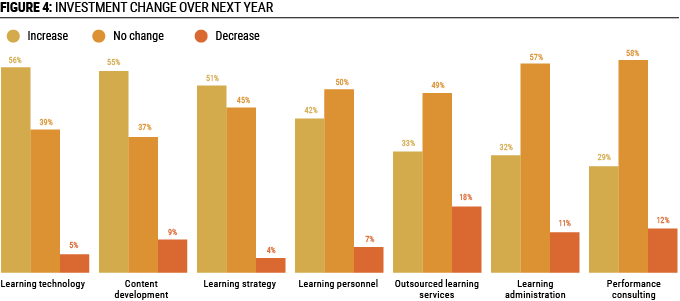During the past several years, learning leaders have maintained an overall optimistic outlook about the growth and funding of their organization’s learning function.
That optimism continues to grow, according to data from the Chief Learning Officer Business Intelligence Board’s “2019 Learning State of the Industry” report. A whopping 71 percent of those surveyed said their outlook for the next 12-18 months is more optimistic than last year (Figure 1). Twenty-two percent said they feel about the same, and 7 percent feel less optimistic.

The Chief Learning Officer Business Intelligence Board is a group of 1,500 professionals in the learning and development industry who have agreed to be surveyed by the Human Capital Media Research and Advisory Group, the research and advisory arm of Chief Learning Officer magazine. This survey was conducted from January to March 2019.
This year’s favorable outlook is the latest in a multiyear pattern of overall optimism. Last year, 65 percent reported being more optimistic than the previous year, 25.5 percent felt the same, and 9.5 percent were less optimistic. Since 2015, a majority of learning leaders have expressed optimism about spending plans, with only a small dip in 2017, when those reporting a more optimistic outlook than the previous year fell to 59 percent.
As of July 2019, the U.S. economy has been growing for a record 121 months, which undoubtedly is at least part of the reason for growing optimism among learning leaders, a majority of whom anticipate an increase in organizational spending on L&D during the next 12-18 months (Figure 2).

The No. 1 investment priority remains the same as reported last year, with 63 percent saying L&D strategy is either essential or high priority (Figure 3). This is fairly consistent with 2018, increasing by only 3 percent. As the pace of change accelerates around us, it’s no surprise that a solid learning strategy aligned with business goals is considered essential.

Notably, content delivery and technology saw the most significant increase in investment priority. A majority of learning leaders (57 percent) now say content delivery is essential or high priority, up from 49 percent last year. And those ranking technology as essential or high priority grew to 49 percent, up 6 percent from 2018. This certainly is tied, again, to the accelerating pace of change, but also to the range of ways in which people want to access L&D and the immediacy they demand.
Changes in expected investment align with these priorities: 56 percent of surveyed learning leaders expect to increase investment in learning technology (up from 51 percent last year), 55 percent anticipate increased investment in content development (up from 50 percent) and 51 percent foresee more investment in learning strategy — almost unchanged from 52 percent in 2018 (Figure 4). Notably, 42 percent expect more investment in learning personnel, up from 36 percent last year.

For the time being, the economic picture looks promising, and the future looks bright for learning leaders. The first quarter of 2019 registered a 3.2 percent growth rate, and inflation remained well under control. However, as is noted in a June 2019 United States Economic Forecast for second quarter 2019 from Deloitte Insights, “What happens when Goldilocks wakes up?”














